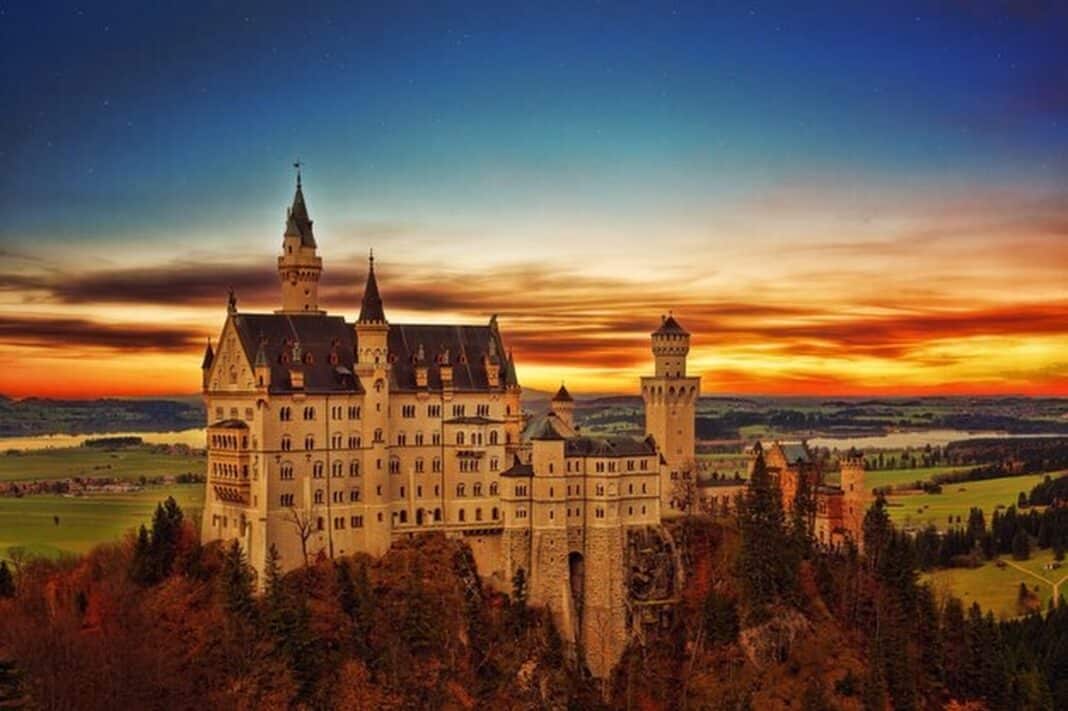German Castle Architecture And Design
German castles are rich in history and innovation. They combine historical styles in their building. Thick walls towers and moats are common defensive elements. Timber and stone were the main materials. Elevated castles were carefully created. This protected and showed off the neighbouring scenery. Castles convey stories about their era interests and necessities. Gothic spires and Renaissance facades show design progression.
Visitors may see architectural advances. Some castles have grand gatehouses and drawbridges. Others have elaborate frescoes and chapels. Germany castles differ from Loire Valley ones. Styles changed how these structures were used. Many were defensive buildings that became residential and administrative facilities. From fortification to the palace is significant. Peace reduced the need for fortification causing this change. The artistic detail improved in many castles. These buildings symbolized riches and power reflecting residents‘ desires. German castle architecture is a fascinating record of the country history.
The Medieval Era A Glimpse into German Castle Life
Medieval German castle life was interesting and difficult. The castle was a village not simply a fort. Within its walls lived nobles knights and their families. Servants artisans and warriors provided vital assistance. Maintenance of the castle and its fields dominated daily life. Defence administration and farming were priorities.
Social hierarchy was vital in castle life. Nobility lived lavishly while poorer classes survived. Events like feasts and contests showed nobles‘ authority. Celebrations and cultural activities built community. Children were educated for social roles. Blacksmiths and carpenters met everyday necessities.
Castles were judicial and government centres. Lords handled disputes and enforced laws. This governance provided stability during difficult times. People and cattle hid in the castle amid raids and disturbances. Castle role changed with time. After feudalism ended many castles became administrative centres. Others were abandoned or reused. The legacy illuminates a dynamic multifaceted civilization.
Legends And Myths The Stories Behind The Stones
Legends and tales surround German castles making them magical. Each castle has a story typically combining reality and fantasy. Ghost treasure and noble curse stories fascinate me. Many generations carry down these beliefs making castles more appealing.
Many tales include historical individuals or events. Local legends may have a betrayed knight seeking retribution. They might be cautionary tales or heroic ones. These constructions are also mystical due to supernatural influences. Castle ruins attract interested travellers with ghostly sightings.
Folklore also shows regional culture. These tales reflect local hopes anxieties and values. They link us to the past. Ancient tales are revived during festivals. Visitors are invited to explore these castles‘ stories. History and mythology inspire contemplation. Overall German castle stories enhance our knowledge of their importance.
From Fairy Tales to Fortresses The Evolution of Castles
German castles went from fairy tales to powerful strongholds. Castles were once defensive. They defended areas and showed strength. Over the decades their duties changed.
Architecture improved with time. Complex stone castles emerged from motte and bailey buildings. These defences included towers curtain walls and elaborate gatehouses. Functionality changed too. Peacetime castles became luxury homes. They symbolized social rank and respect.
Knight and princess stories blurred truth and fantasy. These castles inspired poets and storytellers to romanticize. Castles in chivalry and adventure stories remain alluring. They idealize medieval existence.
Many castles changed by the late Middle Ages. New gunpowder technology rendered previous defences useless. Newer designs prioritized comfort and elegance above protection.
Today German castles are cultural symbols and historical places. Thousands come to witness their enchantment. The story of medieval fortifications becoming fairy tale settings strengthens their attractiveness.
Regional Differences In German Castle Architecture
Germany unique environment inspires different castle styles. Each area has unique styles reflecting its history and culture. From Rhine River castles to Bavarian castles each region has its charm.
Northern stone castles demonstrate medieval defence. Strong castles have strong walls and limited windows. In contrast southern castles may have ornate faade. Example Neuschwanstein Bavaria. Northern castles are functional yet their fairy tale charm stands out.
Central Germany many styles show its past. Castles in this region reflect power movements architectural styles and cultural influences. Royal dynasties and local lords shaped German architecture.
Technology also influenced these constructions. New designs arose as construction processes improved. Stone and timber constructions coexisted. Fortified castles changed aesthetics as combat changed. Artistically ambitious adaptations created spectacular locations.
Regional distinctions show the country varied histories. They show tourists Germany castle heritage intricacy. Architectural variances provide a unique tapestry of prior tales.
Castles As Cultural Heritage Preserving The Past
German castles are cultural treasures with centuries of history. Their maintenance is crucial for future generations. They illuminate medieval culture architecture and regional identities. These sites are restored to preserve their integrity and make them public.
Governments non profits and communities work on preservation. These alliances are essential for castle preservation. Tourism and historical protection initiatives fund it. Conservation and tourist interaction must be balanced urgently.
Educational activities and visits are crucial for awareness. They educate tourists about these monuments‘ cultural significance. History and architecture may be better understood via interactive experiences. Preservation promotes local handicrafts and traditional skills.
Interest in restoration initiatives may contribute to communal pride. Local stories and myths contribute to these castles‘ cultural relevance. These tales increase visitor empathy and stewardship.
German castles demonstrate persistence and flexibility via preservation. They represent national memory. Engaging with historic places promotes belonging and continuity. Their legacy encourages historical study.
Are There Guided Tours Available At German Castles
Many German castles provide guided tours improving the tourist experience. To suit different interests tours vary in duration and substance. Some concentrate on architecture others on regional history or folklore. Historical places are better understood and appreciated with guided excursions.
A skilled guide usually leads these excursions. Their amazing tales bring the past to life. Audio guides are available at several castles for self guided tours. This flexibility lets visitors interact with the content as they choose.
During high tourist seasons booking a tour in advance is advised. Popular castles may be crowded so guided tours are a well planned experience. Thematic or family friendly excursions may be offered on certain days.
Many castles welcome foreign travellers and provide bilingual tours. Guided tours enhance castle visits and expand cultural experiences.
What is the best time of year to visit Germany castles
German castles are amazing and each season is different. Spring and October are popular tourist seasons. Outdoor exploration is better in mild weather. These seasons are less crowded accentuating the spectacular buildings and sceneries.
Summer is appreciated for its longer days and lush foliage. Castle festivities are great in this season. Visitors might expect more people during the high season.
Castle visits are much more magical in winter. Some castles are elegantly decorated for the holidays. Snowy scenery evokes fairy tales. While the weather may restrict outdoor activities interior tours are fun.
Events on the castle schedule offer a fun visit year round. Each castle appeal changes with the seasons. Germany castles remain magical year round with these unique experiences.




